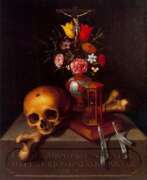Allegory Tenebrism


Tomas Hiepes was a distinguished Spanish painter from the Kingdom of Valencia, celebrated for his contribution to the Baroque movement. Hiepes specialized in still life and bodegón, a genre depicting pantry items, creating artworks that resonated both with private clients and public events. His career, particularly active from the second decade of the 17th century until his death, marks a significant period in art history, with most of his recognized works produced after 1642.
Hiepes' artistic mastery is evident in his depictions of everyday objects, fruits, particularly grapes, and flower vases, which became iconic in the Valencia region during the 17th and 18th centuries. His unique style of flower painting, focusing on the natural beauty and intricate details of his subjects, positioned him as a pivotal figure in art history. Museo del Prado hosts the most extensive collection of his works, highlighting his significance in the realm of Baroque art.
His works, such as "Still Life of Grapes" (1649) and "Still Life with Grapes" (1655), exemplify his skill in blending realism with the artistic flair typical of the Baroque period. These paintings not only showcase his ability to render subjects with stunning accuracy but also reflect his thematic versatility, ranging from religious motifs to allegorical representations.
For collectors and experts in art and antiques, Tomas Hiepes offers a fascinating insight into Spanish Baroque still life painting, with his works serving as a testament to the rich cultural and artistic heritage of the period. His legacy continues to inspire and captivate audiences, affirming his place among the celebrated artists of his time.
To stay informed about new discoveries, sales, and auction events related to Tomas Hiepes, consider signing up for updates from art galleries and auction houses. This subscription ensures access to the latest information and opportunities to engage with the works of this remarkable Baroque painter.